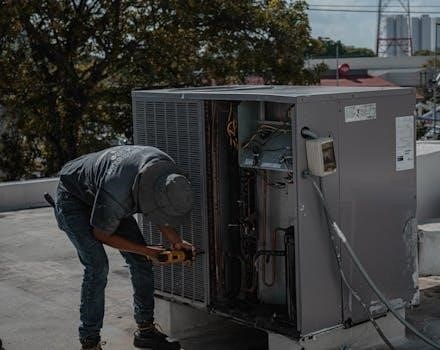GE Air Conditioner Manual⁚ A Comprehensive Guide
Welcome! This guide provides detailed information for your GE air conditioner. We cover everything from initial setup to troubleshooting. Find operating instructions, safety precautions, and maintenance tips. Ensure optimal performance and longevity of your GE unit with this manual.
Understanding Your GE Air Conditioner Model
Identifying your specific GE air conditioner model is crucial for accessing accurate information and ensuring proper maintenance. The model number, often found on a sticker located on the unit’s side, back, or front panel (sometimes behind the filter), unlocks a wealth of knowledge. This number allows you to download the correct owner’s manual from the GE Appliances website, providing detailed specifications and usage guidelines tailored to your device.
Different models boast varying BTU ratings, indicating their cooling capacity for different room sizes. Some feature smart capabilities, enabling control via mobile apps. Knowing your model helps you understand unique features like “Health Anion” functions (if available), specific filter types required, and compatible remote-control functions. The manual also includes essential warranty information and details on available support resources.
Accurate model identification ensures correct installation according to the installation instructions. It also guides you in selecting the right replacement parts and accessories, maximizing your air conditioner’s efficiency and lifespan. GE offers a range of air conditioners, and each model has unique characteristics.
Safety Precautions Before Operation
Prioritizing safety is paramount before operating your GE air conditioner. Always ensure the unit is properly installed according to the provided installation instructions. Improper installation can lead to hazards, including electrical shocks and potential fire risks. Before plugging in the air conditioner, verify that the power outlet is correctly grounded and can handle the unit’s electrical load. Never use extension cords or adapters, as they can overload the circuit.
Keep the area around the air conditioner clear of obstructions, such as curtains or furniture, to ensure proper airflow and prevent overheating; Regularly inspect the power cord for any signs of damage, and if found, immediately discontinue use and contact a qualified technician for repair or replacement.
Never attempt to disassemble or repair the air conditioner yourself, as this can void the warranty and pose serious safety risks. Always disconnect the power supply before cleaning or performing any maintenance tasks, such as filter replacement. If you encounter any unusual noises, smells, or malfunctions, turn off the air conditioner and seek professional assistance. These precautions are vital for safe and reliable operation.

Initial Setup and Installation Guide
Before enjoying the cool comfort of your GE air conditioner, proper setup and installation are crucial. Begin by carefully unpacking the unit and verifying that all components are present, including the mounting hardware, window panels (if applicable), and the remote control. Consult the included installation instructions specific to your model for detailed steps.
For window units, ensure the window opening is the correct size and structurally sound to support the air conditioner’s weight. Securely attach the window panels to the unit, following the manufacturer’s guidelines, to create a tight seal and prevent air leaks. If installing a through-the-wall unit, professional installation is recommended to ensure proper wall preparation and secure mounting.
Once the unit is in place, plug it into a grounded electrical outlet that meets the air conditioner’s power requirements. Avoid using extension cords. After powering on, test the unit’s various functions to confirm they are working correctly. If you encounter any difficulties or have questions during the installation process, consult the GE Appliances website or contact their customer support for assistance. Correct installation guarantees efficiency and safety.
Operating Modes and Functions Explained
Your GE air conditioner offers several operating modes and functions designed to provide customized comfort. Understanding these features allows you to optimize your cooling experience and energy efficiency. The primary modes typically include Cool, Fan, and Dry (Dehumidify).
Cool Mode⁚ This is the standard cooling operation, where the air conditioner actively cools the room to the set temperature. You can adjust the temperature using the up and down buttons on the control panel or remote. The fan speed can also be adjusted to your preference, affecting the cooling rate and airflow.
Fan Mode⁚ In fan mode, the air conditioner circulates air without actively cooling it. This is useful for gentle air movement and can help distribute air from other sources, such as open windows. Different fan speeds are available to control the airflow intensity.
Dry Mode (Dehumidify)⁚ This mode removes moisture from the air, reducing humidity levels. It’s ideal for damp environments or when you want to improve comfort without significantly lowering the temperature. The fan speed is usually preset in this mode to optimize dehumidification.
Additionally, some models feature an “Auto” mode, where the air conditioner automatically selects the appropriate mode based on the room temperature. There may also be a “Sleep” mode, which gradually increases the temperature overnight to save energy and maintain comfort.
Using the Remote Control Effectively
The remote control is your primary interface for managing your GE air conditioner’s functions from a distance. Familiarizing yourself with its buttons and features is key to convenient operation. Typically, the remote includes buttons for power, mode selection (Cool, Fan, Dry, Auto), temperature adjustment (up and down arrows), fan speed control, timer settings, and potentially other specialized functions.
To effectively use the remote, always ensure it has fresh batteries. Point the remote directly at the air conditioner’s receiver, usually located on the front panel. Obstructions can interfere with the signal.

The “Mode” button cycles through the available operating modes. The temperature buttons allow you to set your desired room temperature in Cool mode. Fan speed options usually include Low, Medium, and High, affecting airflow and cooling intensity.
The timer function enables you to schedule the air conditioner to turn on or off at specific times. This is useful for energy saving and pre-cooling a room before you arrive. Some remotes have a “Sleep” mode button, which gradually increases the temperature during the night for comfortable sleep.
Consult your specific model’s manual for detailed information on all remote control functions and any unique features it may offer. Proper understanding of the remote maximizes your control and comfort.
Timer and Scheduling Features
GE air conditioners often include timer and scheduling features, enhancing convenience and energy efficiency. These functions allow you to program the unit to automatically turn on or off at specific times, optimizing cooling according to your needs and reducing energy consumption when you’re away or asleep.
The timer function typically allows you to set a specific duration for the air conditioner to run before automatically shutting off. For example, you can set a 2-hour timer before going to bed, ensuring the room is cool while you fall asleep without running the unit all night.

Scheduling features offer more advanced control, enabling you to set specific on and off times for different days of the week. This is ideal for maintaining a comfortable temperature throughout the day based on your regular schedule.
To set the timer or schedule, consult your air conditioner’s manual for detailed instructions. The process usually involves using the remote control to navigate the timer settings and input the desired times. Some models may also offer smart features, allowing you to control the timer and scheduling remotely via a smartphone app.
Properly utilizing the timer and scheduling features can significantly reduce your energy bills while ensuring your home is always at a comfortable temperature.
Airflow Adjustment and Optimization
Optimizing airflow is crucial for the efficient and effective cooling of your space using a GE air conditioner. Proper airflow ensures even temperature distribution and prevents hot or cold spots within the room. GE air conditioners typically offer adjustable louvers or vents that allow you to direct the airflow vertically and horizontally.
To adjust the airflow, locate the louvers on the front of the unit. Most models have levers or knobs that control the direction of the airflow. Experiment with different settings to find the most comfortable and effective configuration for your room. For example, directing the airflow upwards can help circulate cool air throughout a larger space.
Ensure that the airflow is not obstructed by furniture, curtains, or other objects. Blocked airflow can reduce the efficiency of the air conditioner and lead to uneven cooling. Keep the area around the unit clear to allow for proper air circulation.
Regularly check and clean the air filter to maintain optimal airflow. A dirty filter restricts airflow, forcing the air conditioner to work harder and consume more energy. Refer to the filter maintenance section for instructions on cleaning or replacing the filter.
By properly adjusting and optimizing the airflow of your GE air conditioner, you can maximize its cooling performance, improve energy efficiency, and ensure a comfortable environment.
Filter Maintenance and Cleaning Procedures
Maintaining a clean air filter is essential for the efficient operation and longevity of your GE air conditioner. A dirty filter restricts airflow, causing the unit to work harder, consume more energy, and potentially overheat. Regular cleaning or replacement of the filter ensures optimal performance and air quality.
To clean the filter, first, turn off and unplug the air conditioner for safety. Locate the filter access panel, typically on the front or side of the unit. Remove the filter, noting its orientation for correct reinstallation. Use a vacuum cleaner with a brush attachment to remove loose dust and debris from the filter surface.
For a more thorough cleaning, wash the filter with mild soap and water. Rinse it thoroughly to remove all soap residue. Allow the filter to air dry completely before reinstalling it. Never operate the air conditioner without a filter in place, as this can damage the internal components.
The frequency of filter cleaning depends on usage and environmental conditions. In general, clean the filter every two weeks during periods of heavy use. If the air conditioner is used less frequently, monthly cleaning may suffice. Replace the filter if it is damaged or excessively dirty, even after cleaning.
Refer to your specific GE air conditioner model’s manual for detailed instructions and recommended filter replacement schedules. Proper filter maintenance will keep your unit running efficiently and provide cleaner, healthier air.
Troubleshooting Common Issues
Encountering issues with your GE air conditioner can be frustrating, but many common problems can be easily resolved with a few troubleshooting steps. Before contacting a service technician, review these common issues and their solutions.
Problem⁚ The air conditioner is not turning on. First, ensure the unit is properly plugged into a functioning power outlet. Check the circuit breaker or fuse box to see if a breaker has tripped or a fuse has blown. Verify that the power switch on the air conditioner is in the “on” position. Also, confirm that the thermostat is set to a temperature lower than the current room temperature.
Problem⁚ The air conditioner is not cooling effectively. Check the air filter to ensure it is clean. A dirty filter restricts airflow and reduces cooling efficiency. Make sure the air vents are not blocked by furniture or other objects. Confirm that the thermostat is set to the correct cooling mode and temperature. Check for ice buildup on the cooling coils, which can indicate a refrigerant leak or airflow problem.
Problem⁚ The air conditioner is making unusual noises. Loose parts or debris inside the unit can cause rattling or buzzing noises. Turn off the air conditioner and inspect it for any visible obstructions. Squealing noises may indicate a problem with the fan motor or compressor. Contact a qualified technician for further assistance.
If these troubleshooting steps do not resolve the issue, consult the “Understanding Error Codes” section or contact GE customer support for further assistance.
Understanding Error Codes
Modern GE air conditioners often feature digital displays that present error codes when a malfunction is detected. These codes provide valuable information about the nature of the problem, helping you or a technician diagnose the issue quickly.
E1⁚ Room temperature sensor error. This indicates a problem with the sensor that measures the room’s temperature. Try resetting the unit. If the error persists, the sensor may need replacement.
E2⁚ Evaporator temperature sensor error. This error suggests a fault with the sensor monitoring the evaporator coil temperature. Check the sensor connections and wiring. Replacement might be necessary.
E3⁚ Condenser temperature sensor error. This points to an issue with the sensor measuring the condenser coil temperature. Inspect the sensor and its wiring for damage or loose connections. A faulty sensor will require replacement.
E4⁚ Communication error. This error indicates a problem with the communication between the indoor and outdoor units (for split systems). Check the wiring connections between the units. Resetting the system might resolve the issue.
F1⁚ Refrigerant leak. This error suggests a refrigerant leak, which requires professional attention. Contact a qualified HVAC technician to locate and repair the leak, then recharge the system.
F2⁚ Compressor overload. This indicates that the compressor is overheating. Turn off the unit and allow it to cool down. Check for obstructions around the outdoor unit. If the problem continues, a technician should inspect the compressor.
Always refer to your specific GE air conditioner model’s manual for a complete list of error codes and their meanings. If you are uncomfortable performing any repairs, contact a qualified technician.

Advanced Settings and Customization
Many GE air conditioners offer advanced settings beyond basic cooling and fan functions, allowing for a more personalized and efficient cooling experience. Explore these options to tailor your unit’s operation to your specific needs and preferences.
Sleep Mode⁚ This mode gradually increases the temperature setting overnight, promoting energy savings and a more comfortable sleeping environment. The temperature typically rises by a degree or two per hour for the first few hours, then maintains that level.
Eco Mode⁚ Eco mode prioritizes energy efficiency by optimizing the cooling output. It may cycle the compressor on and off more frequently to maintain the set temperature while minimizing power consumption. This mode is ideal for extended periods when maximum cooling is not required.
Fan Speed Customization⁚ Beyond the standard low, medium, and high settings, some models offer finer control over fan speed. Experiment with different speeds to find the perfect balance between airflow and noise level.
Swing Control⁚ Adjust the direction of the airflow using the swing control. This feature allows you to direct the cool air upwards, downwards, or to oscillate automatically for even distribution throughout the room.
Filter Reset Indicator⁚ After cleaning or replacing the air filter, reset the filter indicator. This ensures that the unit accurately tracks filter usage and reminds you when maintenance is needed again.
Smart Features (if applicable)⁚ If your GE air conditioner is equipped with smart features, you may be able to control it remotely via a smartphone app or voice commands. Explore the app’s settings to customize schedules, monitor energy usage, and receive notifications.
Consult your GE air conditioner’s manual for specific instructions on accessing and adjusting these advanced settings; Proper customization can significantly enhance your comfort and reduce energy costs.
Warranty Information and Support Resources
Energy Saving Tips for Efficient Operation
Operating your GE air conditioner efficiently not only reduces your energy bills but also extends the lifespan of your unit. Here are some proven strategies to maximize energy savings without sacrificing comfort.
Maintain a Consistent Temperature⁚ Avoid frequently adjusting the thermostat. Setting a comfortable, consistent temperature and leaving it there is more efficient than constantly raising or lowering it.
Use a Programmable Thermostat⁚ Program your thermostat to automatically adjust the temperature when you are away or asleep. This prevents the unit from cooling an empty room or cooling unnecessarily during cooler periods.
Seal Windows and Doors⁚ Ensure that all windows and doors are properly sealed to prevent cool air from escaping. Use weather stripping and caulk to seal any gaps or cracks.
Close Curtains and Blinds⁚ During the hottest part of the day, close curtains and blinds to block sunlight from entering the room. This reduces the amount of heat that the air conditioner needs to remove.
Use Fans in Conjunction with AC⁚ Ceiling fans and portable fans can help circulate cool air, allowing you to set the thermostat a few degrees higher without sacrificing comfort. This reduces the workload on the air conditioner.
Regularly Clean or Replace Air Filters⁚ A dirty air filter restricts airflow, forcing the unit to work harder and consume more energy. Clean or replace the filter every month or two, or as recommended in the owner’s manual.
Use Energy-Saving Mode⁚ Utilize the “Eco” or “Energy Saver” mode if your unit has one. These modes optimize cooling while minimizing energy consumption.
Schedule Regular Maintenance⁚ Have your air conditioner professionally serviced annually to ensure that it is running efficiently and to identify any potential problems early on.
